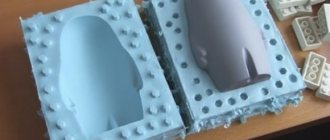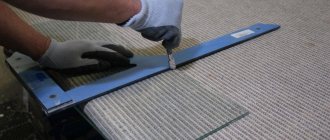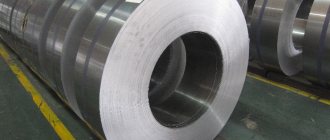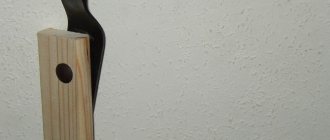We talk about ways to cut acrylic glass with a grinder, hacksaw, cutter and other devices.
ShutterStock
The home handyman has to deal with different materials. It's good to have special tools to handle each one. But this does not always happen; more often an existing universal set is used. Let's figure out how and what to cut plexiglass at home in order to get an accurate cut and not spoil the workpiece.
Suitable Tools
There are many options for cutting plexiglass 2 mm and thicker at home. We will analyze in detail the most effective and easily accessible ones.
Hacksaw
In terms of hardness and processing complexity, plexiglass is comparable to beech. It is enough to simply cut it with a hacksaw or, if the amount of work is small, with a homemade cutter made from cutting blade. For processing, choose a blade with frequent small teeth. First, the workpiece is marked and a cutting line is drawn on it. Most often it is straight. Cutting a curved part with a hacksaw is very difficult. It is good to mark with a felt-tip pen or marker. It leaves a clear trace. You can do it differently. Scratch the line with a sharp nail or knife. You need to saw slowly, avoiding excessive heating of the part. To prevent the blade from sticking, it is recommended to periodically water the cutting area with cold water. The cut from the hacksaw is uneven and requires polishing.
Cutter
It is convenient to use for small volumes of work, when the sheet thickness does not exceed 2-3 mm. Construction stores sell cutting equipment. With its help, straight cuts are made, but curved ones are difficult to make. Before cutting, the workpiece is marked. Then press the metal ruler tightly against the intended line. The cutter is carried with force along the sheet. Do this several times to make a cut about half the depth of the plate. Then they place it on the edge of a table or workbench and break off the edge with a precise movement.
The cut is uneven and needs to be sanded. In some cases, a homemade cutter made from a hacksaw blade for metal is used. They take a blade, sometimes even a used one, and give it a sharp “nose” on a grinding wheel to make it easier to saw. The opposite edge will be the handle. It is wrapped with electrical tape. The homemade cutter is ready. They work with it in the same way as with a hacksaw.
Instagram enerteh.by
Jigsaw
For work, choose only a jigsaw with an adjustable speed. It is best to use metal files; if this is not possible, wood blades will also work. Moreover, they should have small and frequent teeth. With a jigsaw it is possible to make not only a straight cut, but also a curved one. True, this will not be easy to do. In any case, start with markings.
The file is placed on the cutting line and the tool is turned on. Select the lowest speed and minimum speed. Try to move slowly so that the saw does not heat up. If signs of melting of the material appear, stop the work and pour cold water onto the cut. Melting is easy to notice. The plastic in the area of the cut becomes milky white, smoke and a characteristic odor appear.
Instagram elektrika.vld
Instagram plast_ru
Electric milling machine
Using a cutter, you can make a high-quality, even cut, but at the same time the cutting unit works quickly. For cutting, choose a cutter with a thickness of no more than a millimeter. Another disadvantage is that there is a lot of smoke during operation, as the acrylic gets hot. Without cooling, it can not only melt, but also foam. Therefore, it is necessary to supply water to cool the cutting area. The easiest way to supply coolant is from a plastic bottle with a small diameter tube inserted into the cap. In this simple way you can achieve a transparent and even cut.
Is it possible to cut plexiglass with a grinder?
Experts recommend doing this only if the sheet is thick enough. Its thickness must exceed 5 mm. Using a grinder, only straight cuts are made; curved ones are not possible. The tool cuts quickly, the acrylic glass does not have time to overheat and melt. It does not stick to the cutting unit.
For work, choose a disk with three large teeth. It is designed for wood processing, but works well on plexiglass.
How to cut a circle with a jigsaw
If you don’t think about it and take up this matter, then it’s unlikely that anything will come of it.
After all, plexiglass is a very unique material:
All these properties indicate that cutting a circle from this plexiglass is not so easy. Before you begin the cutting process, you need to process the material.
These processing methods are suitable for plexiglass, whose thickness is about four millimeters, but no more. There are also ready-made knives for acrylic. They will help a person with marks and in difficult areas they will help solve various problems.
With this device you can cut up to one centimeter of plastic. This method will also save a lot of time and allow cutting in fairly large quantities.
Using an electric jigsaw you can also do a large amount of work, only in this case it will be more convenient. You can use wood saws. Just don’t need to develop high speed, otherwise the device may fail.
But you need to remember that if the teeth are large, then such files will not work. Very fine teeth are required and the cutting speed must be kept as low as possible.
To cut a circle, you need to draw a circle shape on the fake. Then start cutting into the desired shape.
You should select the cutting option you are interested in and begin the process.
How to cut wood, plywood, chipboard
Despite many questions and attempts to cut wood products with a grinder, many experts do not recommend using this tool for such work, but using other tools for these purposes - jigsaws, circular saws, etc. This is explained by the high degree of danger in the process of performing such work. Among the reasons for increased danger, the most important are:
- There is a possibility that the teeth of the disc will catch a large amount of wood, which will lead to the tool suddenly slipping out of your hands;
- Heating of the disc during the cutting process, which leads to its fragility. In this case, even a slight misalignment causes destruction of the disk, causing its small pieces to fly apart;
- There is a high probability of solder detachment, which can lead to injury to the technician.
Now there is a wide variety of special tools for woodworking. So why risk your own life?
Direct cutting with a hand jigsaw
As mentioned earlier, if you need to keep the strings on the jigsaw, then you can wet the workpiece, this will reduce friction and the process will cool down. And if, on the contrary, it is necessary to carry out work faster and without effects on plexiglass, then it needs to be well heated with an open fire source.
To cut a circle, you need to draw a circle shape on the fake. Then start cutting into the desired shape.
You should select the cutting option you are interested in and begin the process.
Cutting plexiglass at home: methods and recommendations
It would seem, why such a skill as cutting plexiglass might be useful, let the professionals do it, after all, it’s their business. Only on the eve of the holidays does the question arise what surprises and gifts to prepare for your loved ones. I want to be original, to do something special. The stores present a standard set of things that can be found in every second home. All that remains is to make the gift with your own hands. The material is obvious - it is organic glass. Why? You can easily make a wonderful photo frame, an unusual lamp or an aquarium from it. How nice it will be to later hear the gratitude of loved ones and the praise of friends. Remember that cutting organic glass at home requires preparation and care. We will tell you in detail how and what to do.
Nowadays many companies are engaged in the production of things made of organic glass. Of course, the quality of cutting will differ significantly from what you do yourself. Processing specialists use a special laser that cuts organic glass without the slightest errors or inaccuracies. Everything is fine, but such services are very expensive. In addition, an outsider will not be able to implement your entire plan. No matter how detailed explanations he was informed.
So, the process of cutting plexiglass at home is the same as school labor lessons. The correct drawing, selected tools, perseverance, attentiveness, and the result will not be long in coming. To cut in a straight line, you will need a regular jigsaw or a special knife - a cutter. First, clean the plexiglass sheet. Even dust can cause difficulties during cutting. After cleaning, place the sheet of material on a horizontal surface. It should be level and stable. Otherwise, you may be injured and the material may be damaged. Be sure to secure the plexiglass before starting work. Using a ruler, draw the desired lines with a dark marker. It is clearly visible and washes off in one motion. Without removing the ruler, take the knife and draw it with force along the plexiglass.
This must be done until the sheet is cut. Do not overdo it with pressing force, because... Organic glass is weak in strength. This method is convenient because you do not have to additionally process the edges.
You can also cut this material using wire. To do this, you need to heat it up first. Fix the sheet in place. Then draw the wire along the drawn lines. It must be tightened well using a weight. This method is great for shape cutting if you want to make unusual pieces rather than just squares and rectangles. A regular hacksaw for metal can also be used to separate plexiglass. But the blade needs to be sharp. Don't forget about the curly rulers, which are abundant in stores and supermarkets. Do not use fragile rulers.
Sometimes, after cutting, it is necessary to drill holes in the plexiglass for fastening parts, hanging, etc. This can also be easily done at home. You will need an ordinary drill that is used in everyday life. To avoid jamming, you need to fix the material well. Further depending on the thickness of the material. Thin plexiglass is suitable for drills that have a pointed angle of 45 degrees. Tolstoy - 60 degrees. Large diameter holes are drilled at an angle of 70 degrees
Pay attention to the lift angle (should be 17 degrees) and the back sharpening angle (should be between 4 and 8 degrees). Try to avoid overheating of the material, which occurs during prolonged drilling
To do this, turn off the drill every 2 minutes. During breaks, you can remove the resulting chips or cut off the edges of the sheet.
To glue the cut pieces of plexiglass, you will need to degrease them, clean them and make the necessary adjustments. Apply glue in an even layer, and on each part. This will make the fixation clearer and more durable. Please note that when connecting glass with an overlap you need to use a lot of glue.
Choose the most convenient method and act. Make your home special: fill it with interesting plexiglass items. They will not only delight the eyes of the owners, but also of all guests. How nice it will be to hear the praise of friends. You don't have to be an interior designer or have a laser to cut plexiglass at home. A little imagination, a little effort and a few tools will help you realize your most daring and unusual ideas.
Dear readers, comment on the article, ask questions, subscribe to new publications - we are interested in your opinion
How to cut plexiglass at home
It is unlikely that you will often need to cut plexiglass at home. The work of the master is much more professional; in addition, there is no need to install bulky equipment. But the impulses of our inspiration are unpredictable! Perhaps someday you will want to make or repair some original figurine from this material. Therefore, you need to know how to cut plexiglass!
Plexiglas is a thermoplastic plastic, and in principle it can be cut at home. To do this, we need the tools that every thrifty owner has. Most often, a hand saw for metal, a circular saw, a cutter, a milling machine, etc. are used for these purposes. If the sheet is thin - up to 2 mm, then you can get by with a stationery knife.
The easiest way to cut plexiglass at home is to use a hacksaw. The cut area will be rough, so it will need to be sanded.
Dear readers!
If you have any questions about development and production:
➜ housings for electronic equipment;
➜ housings for LED displays and monitors;
➜ shielding structures for electronic devices.
Call: +7(495)642-51-25
or leave a request. We will answer all your questions! It's absolutely free!
Plexiglas is a fairly fragile material (especially when it is thin), so you cannot apply much force when cutting and processing the section. Otherwise, it may break off or crack in the most inappropriate place.
Another tool is a cutter (“single-tooth saw”). In this case, a metal ruler is applied to the sheet and a line is drawn with a cutter along the cut site. This procedure is repeated until the sheet is cut in half. Afterwards, it is carefully broken and the edges are processed to give the resulting workpiece the required shape.
If you do not have the necessary tools at hand, cutting can be done with ordinary glass, remembering to protect your hands.
You can also cut using a circular saw and a cutter for metal with a thickness of 0.5–1 mm.
At home, you can cut plexiglass using a heated nichrome thread. The thread is connected to a source with an output voltage of 24V or less. When heated, nichrome easily cuts (melts) this material. This method is also suitable for figure cutting.
Other devices can be used to cut similar materials. For example, a screwdriver and a soldering iron. Just as in the case of a cutter, a metal ruler is applied to the cut site, and the screwdriver is heated with a 25 W soldering iron to the required temperature. When the workpiece begins to melt, use the tip of a screwdriver to draw a straight line along the edge of the ruler. Then the plexiglass is broken off at the incision site.
Plexiglas lends itself perfectly to processing with a manual wood router, but you need to set 10–12 thousand revolutions per minute.
A wood band saw also works great for this task. When choosing this method of cutting plexiglass, the material does not heat up, but the edge turns out to be a little rough (on wood blanks the cut is also not smooth).
Saw blades for aluminum and plastic also work well with plexiglass. Sharpening is done negatively and a disk with a large number of teeth is selected (for a cleaner cut). The cuts are clean and do not require additional processing.
Despite the apparent simplicity of methods for cutting plexiglass at home, you should not immediately start working with the base material. First, hone your cutting skills on a small piece of workpiece, practice, and only then proceed to the main work.
It is better to entrust work on special machines and installations to professionals. In addition, nowadays the number of such workshops is growing, and the craftsmen can offer you a large selection of the material itself.
Cutter
Polymethyl methacrylate of slight thickness can be cut with a stationery or mounting knife, or a homemade cutter.
In order for the cutting line to be smooth, it is necessary to make markings. You need to place a metal ruler along the intended cutting line and press it firmly with your hand. Using gentle but firm movements, move the cutter along the ruler several times. When the fabric is cut by more than 50%, carefully break the material along the line of the formed fold. Irregularities and roughness must be treated with sandpaper or a grinding machine.
As for the disadvantages, this method of cutting plexiglass requires certain dexterity and skills. Lack of experience and careless movements can cause damage to the building material.
Some features of using industrial equipment
All industrial equipment is characterized by the fact that it allows you to automate the process of cutting composite materials. Today, laser cutting is most often used. Among its features, we note the following points:
- The processing accuracy is about 0.005 millimeters. This is achieved by forming a laser beam of 0.1 millimeters.
- All resulting edges are smooth and transparent, and virtually no waste is generated.
Machines with circular and band saws are most widely used. This is due to their relatively low cost. However, such equipment does not allow processing along a complex trajectory.
During machining, the tool and the material itself can become very hot. Plexiglas is characterized by less resistance to elevated temperatures; when heated, it begins to melt and a large amount of smoke is formed. Air flow or clean water can be used as cooling.
If necessary, you can process plexiglass at home. The following tools can be used for this:
- A hacksaw for metal with a small pitch of teeth. It can be found in almost any garage. It is best to choose a blade made from hardened steel. It dulls at a slower speed.
- Cutter in case of small material thickness.
- A circular saw.
All these tools are inexpensive. However, manual processing does not allow obtaining high-quality products in the shortest possible time.
Hacksaw for metal
A fairly common tool is a hacksaw. It is easy to work with; the steps when processing plexiglass are the same as in the case of metal or wood. Among the features of using a hacksaw for metal, we note the following points:
Cutting lines are marked on a sheet of paper, which greatly simplifies the cutting process. When cutting, attention is paid to the smooth running of the hacksaw, resulting in a high-quality cut. It is not recommended to cut too quickly because the material may heat up. In a plastic state, deformation occurs. The resulting cut in almost all cases turns out to be rough
This is why additional sanding is necessary.
The resulting cut is rough in almost all cases. This is why additional sanding has to be done.
Cutter
A plexiglass cutter is sold in various specialty stores. This tool is suitable if the sheets of material are small in thickness. Among the features of using the cutter, we note the following points:
- To obtain an even cut, use a ruler. It can be made using wood. The ruler must be fixed on the surface to be treated.
- The sheet thickness is cut through 50%, after which you can break the sheet with a slight movement.
- By using a cutter, the cutting process is significantly accelerated, but the resulting cut will be of poor quality. That is why additional grinding is carried out.
If you wish, you can make a cutter yourself or purchase it at a specialty store.
Circular saw or metal cutter
Cutting plexiglass can be done using a metal cutter or circular saw. When choosing a cutter, preference should be given to versions with a thickness of no more than one millimeter. It is worth considering that at the time of cutting, the cutting part wears out quickly.
At the time of cutting with a cutter, a large amount of smoke and heat is generated. Therefore, water should be used to cool the surface. Thanks to gradual cooling, you can get a high-quality cut.
A circular saw should have small teeth that are spaced in small increments. Processing when using a saw with a large tooth pitch can lead to cracks and many other mechanical defects appearing on the surface.
Processing process and applications
At the beginning of work, the profile for cutting is correlated with the graphic layout, due to which maximum accuracy is achieved in the work. Physical surface milling begins only after complete verification, when there is confidence in the accuracy and quality of the result. If it is necessary to deeply process thick glass, the machine will have to go over the surface several times. The work is done in several stages to avoid damaging the material and preventing the formation of chips, cracks and other damage. Milling plexiglass does not leave residue and achieves almost absolute accuracy.
In the advertising field, plexiglass is most often used: For the design of exhibition, presentation and retail premises; For the production of advertising in various formats: both indoor and outdoor; To create showcases, stands, racks; In the design of premises: both exterior and interior.
Modern equipment allows you to order even single copies of something made of plexiglass, so there are practically no restrictions on the flight of fancy. An order for milling a large batch will naturally reduce the cost of processing each part.
Additional processing of acrylic after engraving
If soot does appear, there are several ways to remove it.
- Acetone. After engraving, wipe the areas where carbon deposits have formed with acetone, but it should be used with caution, since prolonged exposure to acetone begins to dissolve the acrylic and a whitish coating appears.
Do not use alcohol under any circumstances; it will cause small cracks that cannot be removed by anything.
- White Spirit. It is also suitable for removing carbon deposits from materials.
- Paste GOI. A small amount of GOI paste is applied to the acrylic and polished, thereby restoring the acrylic surface.
This method is also suitable for removing small scratches.
Method three - circular saw or metal cutter
Do-it-yourself cutting of plexiglass can also be done using a circular saw or a metal cutter
If you choose a cutter, please note that its thickness should be no more than one millimeter. During operation, the cutter operates very quickly
When cutting plexiglass using this method, it is necessary to take into account that a lot of smoke will be released, and the material will heat up quite quickly, possibly foaming at the processing site. To avoid possible consequences, you should take care of cooling the material with water in advance. Cooling can be organized in this way: take a regular bottle and fill it with water, fix it near the cutter and supply water to the work surface using a plastic hose. If you use a hose with a thickness of 2.5 mm, about one liter of water will flow out per hour. By establishing this cooling method, you will be able to obtain a neat and transparent cut.
- You can build a tool to cut this material. You will need nichrome thread. As a result of heating, it will be able to cut plexiglass due to melting. To build such a tool, take a nichrome thread, a transformer with a power of 24 V. Connect the thread to the transformer, first securing it on both sides or attaching a handle to one side and hanging a weight on the other. Once the thread is hot, you can cut the acrylic along the marked mowing line.
- Slotted screwdriver. You need to press a screwdriver onto the sheet of material; hold it by the edge of the handle. Heat the blade of the tool using a soldering iron. When the sheet of material begins to melt, you can cut it by moving the tool with your hand. To get a straight line, use a metal ruler. After running a mowing line across the surface of the acrylic, it can be easily broken in the right place.
In addition to the methods listed above, plexiglass can be cut at home using other tools, it can be a jigsaw (you need to choose the right mode) or a glass cutter. Each master, through trial and error, selects his own method that suits him. After studying the information provided, it became clear that cutting plexiglass products is not as complicated a process as it might seem at first glance.
How to cut a circle with a jigsaw
If you don’t think about it and take up this matter, then it’s unlikely that anything will come of it.
After all, plexiglass is a very unique material:
- it heats up quickly and contributes to tool breakage;
- if you handle it roughly, it may crack;
- in order not to break the strings of the jigsaw, you must not apply force;
All these properties indicate that cutting a circle from this plexiglass is not so easy. Before you begin the cutting process, you need to process the material.
It can be processed using a diamond stone or grinder, using a metal file and using other tools. This is necessary so that the plexiglass is easily exposed and does not cause inconvenience.
These processing methods are suitable for plexiglass, whose thickness is about four millimeters, but no more. There are also ready-made knives for acrylic. They will help a person with marks and in difficult areas they will help solve various problems.
Acrylic cutting can also be done using electrical equipment. For example, on a special cutting tool, a tridental saw blade is installed, which is designed for sawing plexiglass.
With this device you can cut up to one centimeter of plastic. This method will also save a lot of time and allow cutting in fairly large quantities.
It is important not to develop too much speed, otherwise the disk may overheat and simply burst, which can result in injury.
Using an electric jigsaw you can also do a large amount of work, only in this case it will be more convenient. You can use wood saws. Just don’t need to develop high speed, otherwise the device may fail .
Attention, before performing work you need to lubricate the surface with water to reduce friction and for cooling
But you need to remember that if the teeth are large, then such files will not work. Very fine teeth are required and the cutting speed must be kept as low as possible.
Please note that in order to complete the work without defects, the plexiglass must be heated with fire (gas torch, lighter, etc.)
Peculiarities
It is important to consider that the physical properties of the polymer influence the power tool when cutting plexiglass. Because of them, problems often arise, how to cut plexiglass at home
It begins to melt as soon as the temperature reaches 160 degrees. You can bend it when it reaches only 100 or even 90 degrees. As a result, thick slabs cannot be processed using a simple circular saw. We have to resort to other options.
This material has plenty of pros and cons. The benefits include:
- high light transmittance;
- low thermal conductivity;
- resistance is five times higher than that of glass;
- environmental cleanliness;
- resistance to bacteria, moisture, microorganisms;
- electrical insulating properties.
The bad thing is that acrylic is prone to surface damage, catches fire easily, and microcracks often occur at the bend points.
There are many tools on the market that allow you to make an even cut.
Production cutting methods
On an industrial scale, plexiglass is processed using the following technologies:
- Milling cutting. Processing takes place on special milling machines with rotation speeds of up to 4000 rpm.
- Band-saw. Used for curved cuts. Final grinding is required as the cut quality is poor.
- Circular Saw. You can get an even cut with a clean edge.
Laser cutting
The most popular method of processing plexiglass is laser cutting. The material is cut using special equipment using a laser beam. The method guarantees a high level of accuracy (up to 0.005 mm) and a minimum amount of waste. The laser allows you to make cut edges smooth and transparent. However, after cutting on a laser machine, high internal stress remains in the plexiglass, and gluing parts made using this method is not recommended.
How is it possible to process plexiglass?
Plexiglas is lightweight, but at the same time it is highly durable and can be available in various colors. It is used to make accessories for the bathroom, kitchen, and you can even use it to build a gazebo in the courtyard of a private house.
And that’s not all - plexiglass serves as a material for the manufacture of product cases, decorative panels, three-dimensional figures and letters; it is used for “modding” computer cases and dynamic lighting installations.
A characteristic feature of plexiglass is that the flow of light spreads evenly in it; at night it looks very beautiful. Thus, plexiglass is used everywhere, but it must be processed in a way convenient for you.
The main advantages of plexiglass:
- transmits light well - 92%, this indicator does not change over time, and the product itself does not lose its color;
- high impact resistance - five times more than glass;
- moisture resistance;
- harmless to the environment, no harmful gases are released when it burns;
- processing plexiglass is a simple process;
- can take different shapes when exposed to an industrial heat gun, the optical properties will not change, the detailing is very good;
- mechanical processing of plexiglass is no more difficult than wood;
- stable in the external environment;
- not afraid of low temperatures;
- 73% of ultraviolet rays penetrate through it, from which the material does not change color or deform;
- resistant to chemical influences;
- has electrical insulation properties.
Processing plexiglass must be done very carefully, otherwise it can be scratched very easily. But at the same time, it has an undeniable advantage over ordinary glass - plexiglass does not break and can be given any shape. To accurately process this material, you need to know how this can be done, have a special machine and tools.
Processing plexiglass must be done very carefully, otherwise it can be scratched very easily. But at the same time, it has an undeniable advantage over ordinary glass - plexiglass does not break and can be given any shape. To accurately process this material, you need to know how this can be done, have a special machine and tools.
This glass is distinguished by the fact that it is at the same time beautiful, transparent, durable and not heavy; in some cases it is suitable for replacing glass and plastic. Processing of plexiglass can be carried out by sawing, planing, turning.
Its cutting differs depending on the conditions under which it is carried out - on special equipment in a workshop or at home.
It is important not to scratch it to prevent microcracks.
Plexiglas can be produced using one of two methods: extrusion (extruded plexiglass) or casting (cast, cast plexiglass).
Processing of plexiglass can be done by cutting, drilling, grinding, milling, polishing, welding and gluing. In order to create a specific design for a product, thermoforming (hot forming) and cold bending are used.
Turning
When turning a plexiglass part on a lathe, cutters with carbide plates are used for roughing, and the maximum cutting depth of plexiglass in size should not be more than 6 mm. Fine processing is performed with tool steel cutters. For cooling, drilling emulsions or emulsion oils compatible with organic glass are used.
Turning is the most optimal way to produce disk-shaped parts from sheet blanks. They are clamped with a bag between the tailstock of the machine and the chuck and ground down to the desired size. In a few passes.
How to cut plexiglass into shapes
In some cases, it may be necessary to perform figure cutting. This is done in the following ways:
- With a caliper. Plexiglass is cut using sharp sponges for marking.
- Nichrome thread. A template is made from cardboard and glued to the workpiece. For convenience, the wire can be secured in a simple jigsaw instead of a blade. Then you need to carefully cut out the plexiglass part according to the template.
- You can use a glass cutter to cut a circle. The suction cup is attached to the center of the intended circle, then a strip or ruler is attached to it. The glass cutter is rigidly attached to the rail with self-tapping screws. By turning the cutting tool around the suction cup, a groove is cut in the plexiglass. Excess parts are broken off.
Processing machine
Modern equipment provides processing of both flat and spatial surfaces. Typically, acrylic plastic is first milled and only then bent. Therefore, console machines - with a work table - are most widespread.
A sheet of material is fixed to the console. The cutter is a finger type, inserted into the milling head manually or automatically. Control can be manual, automatic or CNC.
Specifications
Based on the type of movement of the table and milling head, machines are divided into 4 groups:
- vertical milling - the work table moves in the horizontal direction - longitudinal and transverse, the milling head moves only vertically;
- cantilever milling - the table moves in all three directions, and the working tool is stationary;
- In longitudinal milling machines, the table moves in the longitudinal direction. The headstock moves in the transverse direction, and the movable crossbar on which it is attached moves in the vertical direction;
- widely universal - the work table moves along the X and Y axes, and the spindle head moves along the Z axis. The difference with the first option is the vertical position of the console.
Milling and turning machines are produced for different purposes. Their design, drive power, and control method can be very different.
- Mini milling machines - designed for home workshops, also used for educational purposes. They are available with both manual and numerical control, which significantly expands the capabilities of the home craftsman.
- Tabletop - designed for individual use, but in fact they are successfully used in small industries.
- Vertical milling machines are production equipment with a large number of possible operations.
Large format – designed to work with voluminous material.
Advantages
- No microcracks - mechanical processing with a milling cutter does not create stress on the edge, which eliminates chipping and the danger of cracking of the material during bending.
- The ends are smooth when cutting. If necessary, the edge can be made transparent, as with laser cutting.
- Milling is the only way to get a three-dimensional image, and not just engraving, because the milling cutter allows you to choose the material.
- The thickness, depth and configuration of the grooves are not limited.
- The milling machine allows you to cut sheets with a large thickness - up to 40 mm.
- Mechanical cutting does not affect the chemical composition of the material. Some types of plexiglass - foamed, PVC, contain chlorine. Under the influence of high temperature, a chemical reaction begins with the release of chlorine, which completely eliminates, for example, laser processing. The rotation speed of the cutter does not produce such a temperature: it is completely safe to engrave the material.
Cutter and feed speed
The best results are achieved using cutters of small diameter but with high rotation speed. The latter depends on the power of the device and the size of the cutter itself.
On mini-machines the rotation speed is 400 rpm, on large-format universal equipment - up to 24,000 rpm.
The feed rate, that is, the speed of movement of the console, is determined by the type of operation, the thickness and depth of the line. Thus, for cutting and sampling, the feed is made at a speed of 5–6 mm/sec, for engraving – 1–2 mm/sec. These values vary widely, since the speed is no less influenced by the complexity of the pattern.
An important factor for ensuring high speed of work is cleaning the working surface from milling dust and blowing it with cold air.
Laser method
The design of the equipment is not much different from a milling machine, but the working tool here is a laser beam up to 0.1 mm thick. Laser processing has both its advantages and disadvantages.
- The laser beam allows you to cut and engrave material with a minimum thickness, which is impossible for a mechanical cutter. On the other hand, a sheet of large thickness for machines with a power of 60–120 W, which is the majority, poses a problem.
- Cutting and drawing are extremely precise; mechanical errors are excluded in this case.
- The ends after laser processing are sharp and transparent. However, there is a special technology that allows lasers to produce smooth edges.
- The thickness and depth of lines are limited. The fact is that the laser does not select the material like a cutter, but cuts out thin longitudinal lines until they form a wider one - the shading method. It is unprofitable to obtain wide and deep stripes in this way.
- The laser cannot process material that can be deformed or undergo a chemical reaction under the influence of temperature.
Safety precautions
When working with this material, many dangerous tools are used, which must be handled carefully and carefully:
- You need to wear gloves on your hands.
- Caution is also needed when working with adhesives. They contain a solvent that is classified as a hazardous material. When working with it, a fire may occur.
- Direct contact of glue with skin is also harmful to humans. Therefore, during such work it is necessary to stay as far as possible from sources of sparks and open flames.
- Ventilation is also needed, and it is better to use safety glasses when working.
All about cutting plexiglass yourself
Jigsaw
For work, choose only a jigsaw with an adjustable speed. It is best to use metal files; if this is not possible, wood blades will also work. Moreover, they should have small and frequent teeth. With a jigsaw it is possible to make not only a straight cut, but also a curved one. True, this will not be easy to do. In any case, start with markings.
The file is placed on the cutting line and the tool is turned on. Select the lowest speed and minimum speed. Try to move slowly so that the saw does not heat up. If signs of melting of the material appear, stop the work and pour cold water onto the cut. Melting is easy to notice. The plastic in the area of the cut becomes milky white, smoke and a characteristic odor appear.
Acrylic engraving
Engraving has its own peculiarities. Engraving is also performed with weak airflow, just like cutting, with the exception of contour engraving, it is performed without airflow.
Contour engraving is performed at minimum power and without blowing onto the lens, the main thing here is that thin lines form on the surface of the material.
At the same time, you should monitor the cleanliness of the lens and mirrors; if the machine has been working for a long time without airflow, it is necessary to wipe them after completing the work.
Before engraving, you need to remove the film that is on the material.
To prevent carbon deposits from appearing on the material, before engraving, it is advisable to cover the surface with a thin layer of soap solution and wait for it to dry.
After engraving, the soap solution is removed and a surface without carbon deposits is obtained along the edges of the engraving.
Methods for cutting plexiglass
If you decide to start making some acrylic products, or perhaps you need to repair an existing product, then you may well need to saw it to remove the deformed element. The following methods are available at home:
- Use a hacksaw for metal.
Plexiglas with a thickness of 8 mm can be easily cut with this tool, but be prepared for the fact that the cut area will be sloppy and will require additional grinding with a file or needle file. - You can use a cutter.
The method is as follows: a metal ruler is pressed onto the plexiglass element that needs to be cut, then it is carried out a couple of times with a cutter. The thickness is cut to half and it is carefully broken off. - A circular saw will also work; it can easily handle 8 mm or thicker organic glass.
Some craftsmen use metal cutters with a thickness of 0.5-1 mm. When working with cutters, they work relatively quickly, this leads to the release of smoke, while the surface becomes rough, and due to the high temperature it can foam. To avoid this result, the saw must be cooled during operation. To do this, you can install a container of water on one side of the cutter and supply it from there through a plastic hose. By organizing such cooling, you can achieve a neat and transparent cut. - If you need to cut an 8 mm or other sheet of plexiglass not along a straight line, you can use nichrome thread.
To do this you will need to build a small cutting tool. The nichrome thread will need to be thoroughly heated; for this it is connected to a 24V or less transformer. When the thread is heated, it can be used to cut acrylic along a pre-designated trajectory. - Another method for cutting plexiglass with a thickness of 8 mm or with other parameters is to use a slotted screwdriver
. Applying its end to the cut site, the blade is heated using a 25W soldering iron. When the temperature reaches the melting point of the material, with a sharp movement it is necessary to draw a straight line along the guide ruler. After that, all that remains is to simply break off the part, this will be very easy to do.
As can be seen from the information provided, cutting plexiglass at home is a completely simple task. Home craftsmen use the listed methods, and also adapt and come up with more convenient and accessible methods. This way you can use a jigsaw, and if the thickness of the material is less than 2 mm, even an ordinary stationery knife can handle the cutting.
Regardless of the chosen method of cutting or cutting plexiglass, to obtain a neat cut area, it is recommended to sand it and then polish it.
Cutting plexiglass is unlikely to be useful very often at home; more often glass products are made by craftsmen. But, who knows, maybe in everyday life you will want to make some kind of trinket for the soul with your own hands, or you will have to repair a plastic product at home, and you will already know the skill of cutting plexiglass.
Plexiglas is a lightweight, durable material, available in different colors. And how many completely unexpected products come out of it. For example, accessories for the bathroom and kitchen look beautiful in the photo, and at the dacha it would be nice to put up a gazebo made of artificial glass. In a word, there is a use for plexiglass, you just need to learn how to process it correctly and choose the appropriate method for cutting glass from plastic.
What can you do with a grinder and where to start?
This tool allows you to confidently cut, grind, clean and polish many well-known materials, such as concrete and tiles, metal and wood, brick and others. In this case, for each specific type of work, a special replaceable nozzle will be required. In some cases, such a tool can be used for other purposes, such as cutting glass with a grinder or sharpening cutting surfaces (knives, drills, etc.).
READ Which jigsaw to cut a 38 mm countertop
This power tool is indispensable in the process of construction or repair work. It is actively used in auto repair shops, utilities, during rescue operations and in other areas of our lives. In other words, angle grinders are widely used in industry and in everyday life.
The work itself as an angle grinder is a high-risk operation. Before you start, it is important to prepare the tool itself. In this case, the choice of nozzle plays a special role. It is important to consider the following points:
- The diameter of the saw blade - the smaller its value, the greater the rotational speed, which means it is able to withstand a greater number of revolutions;
- The working material directly affects the choice of consumables. For example, for metal pipes an abrasive disc, and for concrete. diamond;
- Carefully study the symbols and labeling of such consumables. This will allow you to understand whether this attachment is suitable for the intended job.
Angle grinder discs are actively used in various operations and must be changed for different materials. Moreover, each of them has unique properties and design. This is why it is so important to choose the right consumables for your grinder.
Depending on the purpose they are:
- cutting - for cutting or sawing materials;
- saws – for cutting various wood products;
- roughing – for grinding metal, concrete and wooden workpieces;
- strippers - for removing rust from metal surfaces and eliminating other types of persistent contaminants.
The most common types of cleaning discs include flap wheels. Such tools are suitable for processing materials made of metal, plastic and wood.
- Disconnect the tool from the mains and jam the rotation shaft with the attachment using a special button;
- The lock nut must be unscrewed. To do this, use a key with two protrusions;
- Remove the old disk. After this, a new one can be installed on the mounting flange;
- Screw in and secure the lock nut with a wrench.











